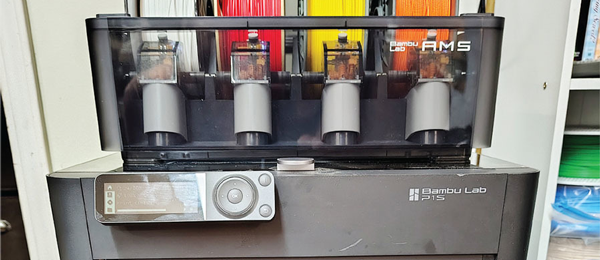By Don Slusarczyk | [email protected]
As seen in the July 2025 issue of Model Aviation.
I RECENTLY BOUGHT a Bambu Lab P1S printer during the Thanksgiving holiday sale at my local Micro Center. I was hesitant to buy a Bambu printer because I had read that there were some issues with it when it came to 3D-printed airplanes. I had held off buying one since Bambu printers are a bit more expensive than the Sovol printers I have been using. I did not want to invest the money then find out that it would not work well for 3D-printed aircraft.
As time passed by, I started seeing the excellent results people were getting on printed airplanes. Model designers were also providing guidance on any special settings that might be needed for their designs, so I decided it was time to finally buy one.

I bought the Bambu P1S with the Automatic Material System (AMS). The AMS is an attachment that holds up to four rolls of filament. This allows the automatic switching of materials or colors when printing, or it can allow the automatic starting of a new roll when one roll runs out.
The Bambu printer has several features that my current printers do not. The first is an enclosed heated frame, which is needed for materials such as acrylonitrile styrene acrylate (ASA) or acrylonitrile butadiene styrene (ABS) that have to be printed in an elevated temperature environment. It also prints at much higher speeds, which means that the total printing time for an airplane is reduced.
Other features include automatic bed-leveling before each print, automatic filament loading and head priming, wireless transfer of G-code files, an internal camera to monitor the print status, and notifications sent to your phone when a print is completed.

Bambu uses its own slicing software called Bambu Studio. At first, I was put off by the thought of having to learn yet another slicer software, but I was pleasantly surprised that the interface was easy to navigate. The company also has an extensive online support page that covers just about anything that I can think of.
The assembly and setup of the printer was quite easy, and it was not long before I had test parts printing. Once I was comfortable with the printer, I decided to try printing a few airplanes out.
The first airplane I chose was the twin 50mm EDF C-17 designed by Troy McMillan. His design uses foaming lightweight polyactic acid (LW-PLA), and the parts are designed to be printed in "spiral vase" mode on a Bambu printer. He posted a few quick videos on his website (listed in "Sources") about the special settings for the Bambu printer. I am going to go over these adjustments because they are not obvious changes but have a significant impact on the final result.
The two critical things that need to be changed are the slicing gap closing radius and the resolution—both need to be set to zero. Because many designers use surfaces for modeling, not having these values set correctly can result in missing internal geometry. In addition, I have highlighted some other settings that you need to verify are set correctly, such as the order of walls, which can have an effect on whether you see internal structure embossed on the outside surface of a part.
For printing foaming LW-PLA, I suggest creating a special filament profile to make it easy to select when slicing a part. Set the nozzle temperature to 265°C, the bed plate to 60°C, and set the flow ratio to 0.60. Under the Cooling settings, set the auxiliary part cooling fan to zero. These settings will give excellent results with 3DLabprint Polylight foaming LW-PLA. On my other printers, I usually use a temperature of 240°C, but the P1S likes this higher value. For print speed, I kept the values at 50mm per second because of the foaming action of the filament. For regular PLA parts, the default speed of 200mm to 300mm per second can be used to greatly reduce print time.
After the C-17, I printed the Eclipson Spark Pylon Racing model in PLA and the results were outstanding. They were the best-looking 3D-printed airplane parts that I have printed to date.
So, what are my final thoughts on the Bambu P1S for 3D printing? I think it is a "must-have" for those who enjoy 3D-printed airplanes as a hobby. The faster printing speed and easy ability to print difficult filaments such as ABS or ASA are just a start. I find the overall printed parts quality that I am getting is much better.
If you are looking to try one or two printed airplanes, the cost is a bit high just to test the waters of 3D-printing them, but if you have printed a few and like this aspect of the RC hobby, it is a worthwhile upgrade.




SOURCES:
Bambu Lab
Troy McMillan RC
3DLabprint
Eclipson 3D Printed RC Models










Comments
Add new comment